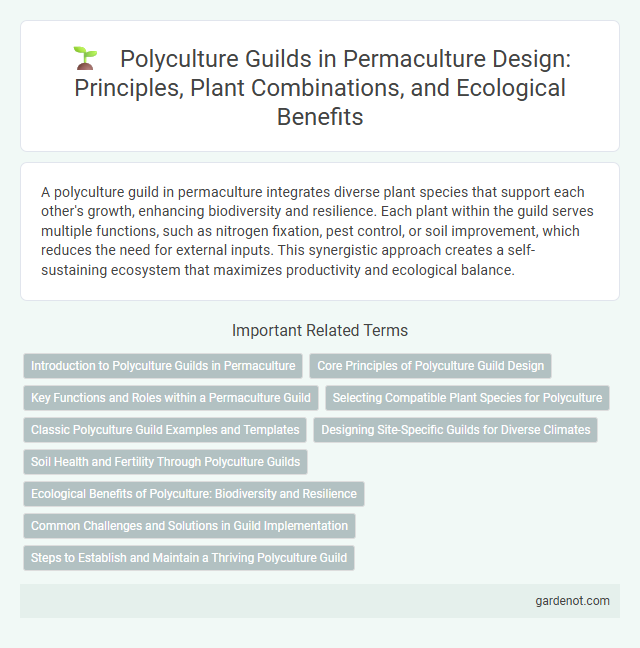A polyculture guild in permaculture integrates diverse plant species that support each other's growth, enhancing biodiversity and resilience. Each plant within the guild serves multiple functions, such as nitrogen fixation, pest control, or soil improvement, which reduces the need for external inputs. This synergistic approach creates a self-sustaining ecosystem that maximizes productivity and ecological balance.
Introduction to Polyculture Guilds in Permaculture
Polyculture guilds in permaculture are designed to create diverse plant communities where species support each other's growth, nutrient cycling, and pest management. These guilds mimic natural ecosystems by combining complementary plants such as nitrogen-fixing legumes, dynamic accumulators, and pest-repellent herbs to enhance soil fertility and biodiversity. Implementing polyculture guilds improves resilience and productivity while reducing the need for synthetic inputs.
Core Principles of Polyculture Guild Design
Polyculture guild design is centered on diversity, complementarity, and resilience, integrating multiple plant species that fulfill different ecological roles such as nitrogen fixation, pest control, and nutrient accumulation. Key principles include plant selection based on functional traits, spatial arrangement to enhance mutual support, and temporal layering to optimize resource use throughout the growing season. This approach fosters ecosystem stability, increases productivity, and reduces the need for external inputs in sustainable agriculture systems.
Key Functions and Roles within a Permaculture Guild
Polyculture guilds integrate diverse plant species performing essential functions such as nitrogen fixation, soil conditioning, pest deterrence, and pollinator attraction to create a self-sustaining ecosystem. Key roles include nutrient accumulators like comfrey, dynamic accumulators capturing vital minerals; ground covers suppressing weeds and retaining moisture; and nitrogen-fixing plants such as clover enriching soil fertility. This synergy enhances biodiversity, resilience, and productivity within permaculture systems.
Selecting Compatible Plant Species for Polyculture
Selecting compatible plant species for a polyculture guild is crucial to enhancing biodiversity and promoting ecosystem resilience. Key considerations include complementary root depths, nutrient requirements, and growth habits to minimize competition and maximize mutual benefits. Integrating nitrogen-fixing plants, dynamic accumulators, and pest-repelling species fosters sustainable productivity and soil health within the guild.
Classic Polyculture Guild Examples and Templates
Classic polyculture guild examples often revolve around the "Three Sisters" system, which combines corn, beans, and squash to enhance soil fertility and maximize space. Another well-known template includes the apple tree guild, integrating nitrogen-fixing plants like clover, dynamic accumulators such as comfrey, and pest-repelling herbs like garlic. These guilds exemplify symbiotic relationships that improve biodiversity, resilience, and productivity in permaculture designs.
Designing Site-Specific Guilds for Diverse Climates
Designing site-specific polyculture guilds requires careful analysis of local climate patterns, soil types, and native plant species to maximize resilience and productivity. Incorporating a mix of nitrogen-fixing plants, dynamic accumulators, and pollinator attractors tailored to the region enhances ecosystem stability and fosters sustainable growth. Understanding microclimates and seasonal variations ensures guild components support each other, creating balanced, diverse, and adaptable permaculture systems.
Soil Health and Fertility Through Polyculture Guilds
Polyculture guilds enhance soil health by integrating diverse plant species that contribute nitrogen fixation, organic matter accumulation, and nutrient cycling. These guilds promote beneficial microbial activity and improve soil structure, increasing water retention and aeration. The synergy between plants in polyculture systems reduces dependency on synthetic fertilizers, sustaining long-term soil fertility in permaculture landscapes.
Ecological Benefits of Polyculture: Biodiversity and Resilience
Polyculture guilds enhance ecological stability by fostering biodiversity, which supports a wide range of beneficial insects, soil microbes, and wildlife, creating a balanced ecosystem. Diverse plant species in polyculture systems improve soil health through varied root structures and nutrient cycling, reducing the need for synthetic inputs. This biodiversity increases resilience against pests, diseases, and climate fluctuations, ensuring sustainable food production and ecosystem services.
Common Challenges and Solutions in Guild Implementation
Polyculture guilds often face common challenges such as competition for nutrients, water, and sunlight among plants, leading to reduced growth and productivity. Effective solutions include strategic plant selection based on complementary root depths, growth habits, and nutrient requirements to enhance resource sharing and minimize competition. Implementing companion planting techniques and maintaining soil health through organic mulching and regular monitoring can significantly improve guild resilience and yield.
Steps to Establish and Maintain a Thriving Polyculture Guild
Establishing a thriving polyculture guild begins with selecting complementary plant species that fulfill diverse ecological roles such as nitrogen fixation, ground cover, and pest deterrence. Prepare the soil by enriching it with organic matter and ensuring proper spacing to promote healthy root development and airflow. Maintain the guild through regular monitoring for pests, pruning for optimal light access, and applying mulch to conserve moisture and suppress weeds.
Polyculture guild Infographic

 gardenot.com
gardenot.com